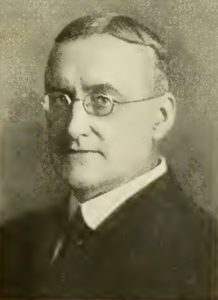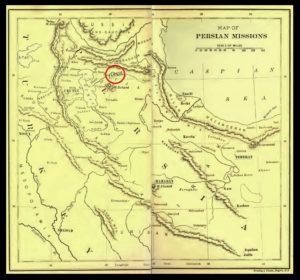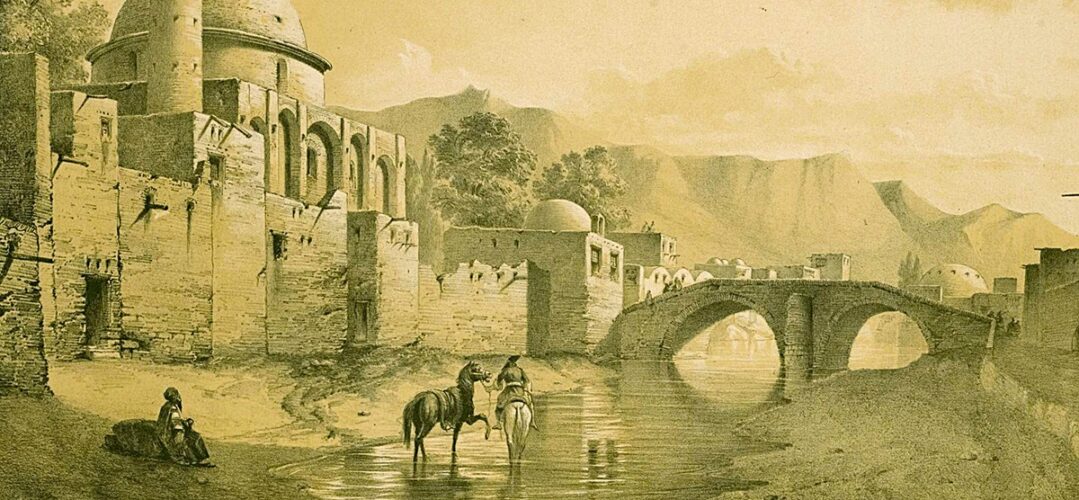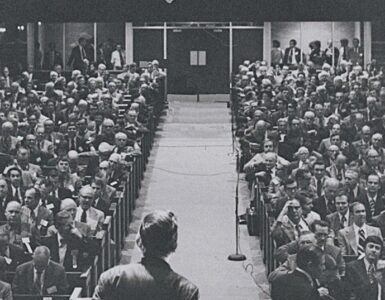 Samuel Graham was born the third son of Andrew Wilkins Wilson and Anna Graham (Dick) Wilson in Indiana, Pennsylvania, February 11, 1858. Andrew was a ruling elder in the local Presbyterian Church and a respected businessman who operated a dry goods store that provided a good living for his household. The family home was built at the corner of Church and Seventh Streets for ten children that included six boys and four girls. Sam attended the public schools in Indiana before entering the College of New Jersey in the fall of 1873 at the age of fifteen. He studied hard but still found time to play football for his class team. While attending Second Presbyterian Church in Princeton, he professed faith in Christ at the age of eighteen. Graduating with him in 1876 was his brother Robert Dick Wilson as well as other Presbyterians headed for ministry such as future minister of Princeton’s First Church, Sylvester W. Beach; Professor William Brenton Greene, Jr., of Princeton Seminary; and James W. Lowrie would become a missionary to China serving for thirty-five years.
Samuel Graham was born the third son of Andrew Wilkins Wilson and Anna Graham (Dick) Wilson in Indiana, Pennsylvania, February 11, 1858. Andrew was a ruling elder in the local Presbyterian Church and a respected businessman who operated a dry goods store that provided a good living for his household. The family home was built at the corner of Church and Seventh Streets for ten children that included six boys and four girls. Sam attended the public schools in Indiana before entering the College of New Jersey in the fall of 1873 at the age of fifteen. He studied hard but still found time to play football for his class team. While attending Second Presbyterian Church in Princeton, he professed faith in Christ at the age of eighteen. Graduating with him in 1876 was his brother Robert Dick Wilson as well as other Presbyterians headed for ministry such as future minister of Princeton’s First Church, Sylvester W. Beach; Professor William Brenton Greene, Jr., of Princeton Seminary; and James W. Lowrie would become a missionary to China serving for thirty-five years.
Wilson’s next step was theological study so he could be ordained a missionary. It would be expected that he would attend Princeton Seminary, but he instead returned to his Pennsylvania homeland to study at Western Theological Seminary in Allegheny. Wilson excelled at the biblical languages and may have been steered to Western by his father who was on the seminary board. The Presbytery of Kittanning licensed Wilson to preach April 4, 1878. When Andrew attended his boy’s first speaking opportunity from a pulpit, he thought Sam just looked too young, which may be why he lectured on Charles Hodge instead of preaching Scripture. Graduating Western the following April he returned to Princeton for a year of philosophy with James McCosh which earned him the A.M. in 1879. Beginning that fall he accomplished additional studies for a year at Princeton Seminary. Following ordination as an evangelist by Kittanning Presbytery, June 19, 1880, he set sail for Turkey and then on to western Persia (Iran).
Wilson’s primary work for his entire tenure in Tabriz, Persia was with what was initially named the Boy’s Training School. For the boys, he translated a catechism into Ararat Armenian (Old Armenian). In 1886 the school added a divinity program, then at some point a girls’ school, and in 1890 the name of the entire complex was changed to the Memorial Training and Theological School. The change of name was to honor an endowment from Mrs. William Thaw of Pittsburgh in memory of her deceased husband. In 1886 Samuel married Annie who was the daughter of missionary Samuel Dwight Rhea. For many years the couple operated the school alone, but as the work developed and grew both missionary associates and short-term teachers from the States increased the faculty. It took the Wilsons several years to change the boys school curriculum from rote reading of the Koran to a curriculum that included languages and sciences. The school at first had only Armenian students until Wilson convinced some Muslim families to enroll their children; by the time of his death half of the 300 boys in school were Muslims. Wilson required daily chapel and regular Bible study from the outset, and these were at no point compromised or discontinued because of the Muslim students. The truth of Christ for Wilson was the greatest truth; he rejected the notion that the truth of mathematics, geography, history, and science should be taught without the truth of Scripture and Christ. It was not only in the school that Dr. Wilson was an evangelist. Even though his work was primarily in Tabriz, he preached in outlying villages on the Lord’s Day sometimes delivering three sermons in three different languages—Turkish, Armenian, and English. The school became the largest mission school in Western Persia and was an influential presence in Tabriz.
During a visit to the United States in 1912, Wilson was seriously injured in a railroad accident. Despite needing further recovery from his injuries, he returned to Persia in 1914 as the First World War was getting underway. Wilson’s work during the war involved not only evangelism but relief work as the Armenians in western Turkey suffered greatly at the hands of the Ottomans. In November, the next year he returned to the States to deliver a lecture series at Western Seminary that was published in Modern Movements Among Moslems, 1916.
No easy work lies before the Church if it would … convert these masses to Christ. Christians should appreciate the greatness of the task. It is indeed a challenge to faith and only a faith which overcomes will undertake it. Such a faith will not falter.…Islam and its increase are calls to us to immediate and all-embracing efforts. A revived Islam, newly incited by the spirit of Mohammed, must be met by a revived Church inspired by the Spirit of Christ. Who can doubt the issue! (p. 111)
Samuel Wilson’s words to the Christians of his era continue to have relevance today.
 Before making his way back to Persia, he received a typhoid vaccination. Annie and the children stayed in the United States. The trip back to Persia was grueling because the residual affects of his accident combined with possible complications from the vaccination weakened him. When he arrived in Tabriz in June the extraordinary welcome of the community and colleagues provided encouragement amid physical weakness and the increasing chaos of war. But unfortunately, Samuel Wilson had something in common with Jonathan Edwards (1703-1758). Edwards died of a smallpox vaccination and Wilson apparently died Sunday, July 2, 1916 from the typhoid vaccination, or possibly from contracting the disease because the vaccination proved ineffective. He is buried in Tabriz. Wilson was survived by Annie, a son, and three daughters. His greatest contribution to the work in Persia was skilled administrative work, business acumen manifested in purchasing property for construction projects, and proficiency leading and encouraging personnel.
Before making his way back to Persia, he received a typhoid vaccination. Annie and the children stayed in the United States. The trip back to Persia was grueling because the residual affects of his accident combined with possible complications from the vaccination weakened him. When he arrived in Tabriz in June the extraordinary welcome of the community and colleagues provided encouragement amid physical weakness and the increasing chaos of war. But unfortunately, Samuel Wilson had something in common with Jonathan Edwards (1703-1758). Edwards died of a smallpox vaccination and Wilson apparently died Sunday, July 2, 1916 from the typhoid vaccination, or possibly from contracting the disease because the vaccination proved ineffective. He is buried in Tabriz. Wilson was survived by Annie, a son, and three daughters. His greatest contribution to the work in Persia was skilled administrative work, business acumen manifested in purchasing property for construction projects, and proficiency leading and encouraging personnel.
In 1906 while visiting the United States he was honored with the Doctor of Divinity by both the Western University of Pennsylvania (became Pitt 1908) and Grove City College. Publications include Persian Life and Customs with Scenes and Incidents of Residence and Travel in the Land of the Lion and the Sun, 1895; Persia: Western Mission, 1896; “The Armenian Church in its Relation to the Russian Government,” The North American Review, January 1905, 88-101; Mariam: A Romance of Persia, 1906; “Bahaism an Anti-Christian System” in Bibliotheca Sacra, October 1915, 1-22; Bahaism and Its Claims: A Study of the Religion Promulgated by Baha Ullah and Abdul Baha, 1915, and numerous articles for Presbyterian and other Christian serials. Annie published a seven-page pamphlet, 1870 Then and Now—Persia 1920. To learn more about missions in Persia, read on this site Shushan Wright, died 1890.
Barry Waugh
Notes— The header image is titled “Tabriz,” is dated 1851-1854, and was published in Paris by Gide et J. Baudry. The map of Presbyterian missions in Persia has Tabriz circled in Red. Sources include the Necrological Report for 1917 published by Princeton Seminary; Princeton Seventy-Six, 1876-1916, Class Record Number X, provided the portrait and a memorial biography, pages 195-201; Robert E. Speer’s memorial article in The Moslem World, volume 7, number 2, April 1917, 191-195. Information about Rhea is from The Tennessean in Persia and Koordistan. Being the scenes and incidents in the life of Samuel Audley Rhea, 1869; Annie was born at Seir, August 24, 1861.





